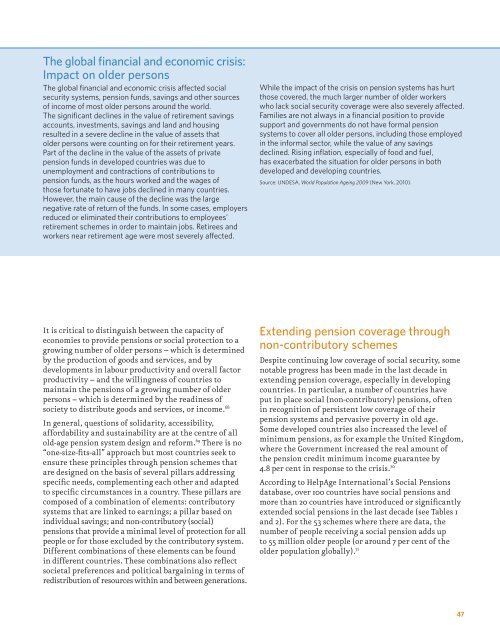Ageing in the Twenty-First Century: - HelpAge International
Ageing in the Twenty-First Century: - HelpAge International
Ageing in the Twenty-First Century: - HelpAge International
Create successful ePaper yourself
Turn your PDF publications into a flip-book with our unique Google optimized e-Paper software.
The global f<strong>in</strong>ancial and economic crisis:<br />
Impact on older persons<br />
The global f<strong>in</strong>ancial and economic crisis affected social<br />
security systems, pension funds, sav<strong>in</strong>gs and o<strong>the</strong>r sources<br />
of <strong>in</strong>come of most older persons around <strong>the</strong> world.<br />
The significant decl<strong>in</strong>es <strong>in</strong> <strong>the</strong> value of retirement sav<strong>in</strong>gs<br />
accounts, <strong>in</strong>vestments, sav<strong>in</strong>gs and land and hous<strong>in</strong>g<br />
resulted <strong>in</strong> a severe decl<strong>in</strong>e <strong>in</strong> <strong>the</strong> value of assets that<br />
older persons were count<strong>in</strong>g on for <strong>the</strong>ir retirement years.<br />
Part of <strong>the</strong> decl<strong>in</strong>e <strong>in</strong> <strong>the</strong> value of <strong>the</strong> assets of private<br />
pension funds <strong>in</strong> developed countries was due to<br />
unemployment and contractions of contributions to<br />
pension funds, as <strong>the</strong> hours worked and <strong>the</strong> wages of<br />
those fortunate to have jobs decl<strong>in</strong>ed <strong>in</strong> many countries.<br />
However, <strong>the</strong> ma<strong>in</strong> cause of <strong>the</strong> decl<strong>in</strong>e was <strong>the</strong> large<br />
negative rate of return of <strong>the</strong> funds. In some cases, employers<br />
reduced or elim<strong>in</strong>ated <strong>the</strong>ir contributions to employees’<br />
retirement schemes <strong>in</strong> order to ma<strong>in</strong>ta<strong>in</strong> jobs. Retirees and<br />
workers near retirement age were most severely affected.<br />
While <strong>the</strong> impact of <strong>the</strong> crisis on pension systems has hurt<br />
those covered, <strong>the</strong> much larger number of older workers<br />
who lack social security coverage were also severely affected.<br />
Families are not always <strong>in</strong> a f<strong>in</strong>ancial position to provide<br />
support and governments do not have formal pension<br />
systems to cover all older persons, <strong>in</strong>clud<strong>in</strong>g those employed<br />
<strong>in</strong> <strong>the</strong> <strong>in</strong>formal sector, while <strong>the</strong> value of any sav<strong>in</strong>gs<br />
decl<strong>in</strong>ed. Ris<strong>in</strong>g <strong>in</strong>flation, especially of food and fuel,<br />
has exacerbated <strong>the</strong> situation for older persons <strong>in</strong> both<br />
developed and develop<strong>in</strong>g countries.<br />
Source: UNDESA, World Population <strong>Age<strong>in</strong>g</strong> 2009 (New York, 2010).<br />
It is critical to dist<strong>in</strong>guish between <strong>the</strong> capacity of<br />
economies to provide pensions or social protection to a<br />
grow<strong>in</strong>g number of older persons – which is determ<strong>in</strong>ed<br />
by <strong>the</strong> production of goods and services, and by<br />
developments <strong>in</strong> labour productivity and overall factor<br />
productivity – and <strong>the</strong> will<strong>in</strong>gness of countries to<br />
ma<strong>in</strong>ta<strong>in</strong> <strong>the</strong> pensions of a grow<strong>in</strong>g number of older<br />
persons – which is determ<strong>in</strong>ed by <strong>the</strong> read<strong>in</strong>ess of<br />
society to distribute goods and services, or <strong>in</strong>come. 68<br />
In general, questions of solidarity, accessibility,<br />
affordability and susta<strong>in</strong>ability are at <strong>the</strong> centre of all<br />
old-age pension system design and reform. 69 There is no<br />
“one-size-fits-all” approach but most countries seek to<br />
ensure <strong>the</strong>se pr<strong>in</strong>ciples through pension schemes that<br />
are designed on <strong>the</strong> basis of several pillars address<strong>in</strong>g<br />
specific needs, complement<strong>in</strong>g each o<strong>the</strong>r and adapted<br />
to specific circumstances <strong>in</strong> a country. These pillars are<br />
composed of a comb<strong>in</strong>ation of elements: contributory<br />
systems that are l<strong>in</strong>ked to earn<strong>in</strong>gs; a pillar based on<br />
<strong>in</strong>dividual sav<strong>in</strong>gs; and non-contributory (social)<br />
pensions that provide a m<strong>in</strong>imal level of protection for all<br />
people or for those excluded by <strong>the</strong> contributory system.<br />
Different comb<strong>in</strong>ations of <strong>the</strong>se elements can be found<br />
<strong>in</strong> different countries. These comb<strong>in</strong>ations also reflect<br />
societal preferences and political barga<strong>in</strong><strong>in</strong>g <strong>in</strong> terms of<br />
redistribution of resources with<strong>in</strong> and between generations.<br />
Extend<strong>in</strong>g pension coverage through<br />
non-contributory schemes<br />
Despite cont<strong>in</strong>u<strong>in</strong>g low coverage of social security, some<br />
notable progress has been made <strong>in</strong> <strong>the</strong> last decade <strong>in</strong><br />
extend<strong>in</strong>g pension coverage, especially <strong>in</strong> develop<strong>in</strong>g<br />
countries. In particular, a number of countries have<br />
put <strong>in</strong> place social (non-contributory) pensions, often<br />
<strong>in</strong> recognition of persistent low coverage of <strong>the</strong>ir<br />
pension systems and pervasive poverty <strong>in</strong> old age.<br />
Some developed countries also <strong>in</strong>creased <strong>the</strong> level of<br />
m<strong>in</strong>imum pensions, as for example <strong>the</strong> United K<strong>in</strong>gdom,<br />
where <strong>the</strong> Government <strong>in</strong>creased <strong>the</strong> real amount of<br />
<strong>the</strong> pension credit m<strong>in</strong>imum <strong>in</strong>come guarantee by<br />
4.8 per cent <strong>in</strong> response to <strong>the</strong> crisis. 70<br />
Accord<strong>in</strong>g to <strong>HelpAge</strong> <strong>International</strong>’s Social Pensions<br />
database, over 100 countries have social pensions and<br />
more than 20 countries have <strong>in</strong>troduced or significantly<br />
extended social pensions <strong>in</strong> <strong>the</strong> last decade (see Tables 1<br />
and 2). For <strong>the</strong> 53 schemes where <strong>the</strong>re are data, <strong>the</strong><br />
number of people receiv<strong>in</strong>g a social pension adds up<br />
to 55 million older people (or around 7 per cent of <strong>the</strong><br />
older population globally). 71<br />
47







